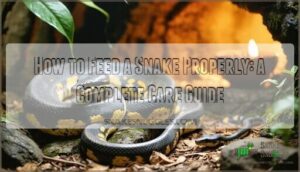This site is supported by our readers. We may earn a commission, at no cost to you, if you purchase through links.
 A ball python refuses its rat for the third consecutive week. The owner panics, imagining worst-case scenarios, unaware that seasonal fasting is normal for many species. This common crisis reveals a fundamental truth: proper snake feeding isn’t just about dropping prey into an enclosure.
A ball python refuses its rat for the third consecutive week. The owner panics, imagining worst-case scenarios, unaware that seasonal fasting is normal for many species. This common crisis reveals a fundamental truth: proper snake feeding isn’t just about dropping prey into an enclosure.
It demands precision in prey selection, timing, and presentation that respects each species’ biology. Snakes digest whole animals slowly, requiring entirely different care protocols than mammals or birds. Temperature fluctuations, reproductive cycles, and shedding phases all influence appetite in ways that confuse first-time keepers.
Understanding these variables transforms feeding from guesswork into a systematic practice that keeps your snake thriving.
Table Of Contents
Key Takeaways
- Successful snake feeding depends on species-specific prey selection and precise sizing (10-15% of body weight), not arbitrary schedules, because evolutionary adaptations create vastly different dietary requirements across the 882+ snake species.
- Frozen-thawed prey eliminates 8-14% injury rates from live rodent bites while reducing parasite transmission by 96%, making it the safest feeding method that also allows for convenient storage and vitamin supplementation.
- Most feeding refusals stem from normal biological cycles—65% occur during shedding, 81% of pythons fast seasonally, and newly acquired snakes refuse food 40% more often—so patience and environmental adjustments typically resolve hunger strikes within four feeding cycles.
- Veterinary intervention becomes critical only when refusal extends beyond 2-4 weeks with over 10% weight loss or accompanying symptoms like respiratory distress, oral lesions, or repeated regurgitation, since 37% of prolonged refusals indicate underlying parasitism or organ disease.
What Does It Mean to Feed a Snake?
Feeding a snake means more than just dropping prey into an enclosure. It’s a careful process rooted in biology, shaped by your snake’s natural hunting behavior and nutritional needs.
Before you offer your first meal, you’ll want to understand what "feeding" actually involves and how it differs from caring for other animals.
Definition of "Feed" in Animal Care
When you feed your snake, you’re doing more than tossing food into a tank. You’re providing the right nutrition to keep your snake healthy, help it grow, and respect the predator-prey relationship it’s hardwired for.
This means knowing what your snake needs to eat and how to feed it properly—you’re supporting your pet’s wellbeing through care that matches its biology and natural feeding instincts.
It’s about knowing what your snake needs to eat and how to feed it right—matching care to biology and natural instincts.
Historical and Linguistic Origins of "Feed
The word "feed" traces back to Old English fēdan, a term our ancestors used before the 12th century to describe the act of nourishing both people and animals—a linguistic root that connects modern snake keepers to centuries of animal husbandry tradition.
What’s fascinating is how this linguistic shift tracks our evolving bond with animals.
The verb captures the act of nourishing, while the noun simply means the food—basic distinctions that still matter when caring for reptiles properly.
Differences Between Feeding Pets and Livestock
The word "feed" works for any animal, but feeding snakes? That’s a different game entirely.
Reptile biology, prey needs, and what you’re responsible for as a keeper set snakes apart from your average pet or farm animal.
Traditional pets consume prepared food daily, while snakes require whole prey items every few days to weeks. Livestock diets prioritize weight gain and production, but proper snake feeding methods emphasize species care and natural consumption patterns.
Get these differences right and you’ll meet your snake’s nutritional needs while keeping them healthy—no guesswork, no borrowed tactics from feeding other animals.
Choosing The Right Food for Your Snake
Your snake’s diet isn’t one-size-fits-all—it depends entirely on the species you’re keeping. Getting the food choice right means understanding what prey your snake naturally eats, selecting the appropriate size, and deciding between live or frozen options.
Here’s what you need to think about when choosing the right food for your snake.
Understanding Species-Specific Diets
Not all snakes are alike regarding food consumption. Among 882 species, researchers documented almost 70% of diet variation traced to seven major evolutionary splits—proof that snake nutrition depends heavily on species adaptation. Your ball python’s prey selection differs drastically from a garter snake’s, with some snakes specializing in rodents while others target amphibians, fish, or even invertebrates.
Understanding your snake’s natural feeding strategies ensures you’re providing the right animal-based food for peak health. Providing a balanced diet with proper reptile nutrition is vital for their overall well-being.
Prey Type and Size Selection
Choosing prey that’s roughly 10-15% of your snake’s body weight—or about as wide as the thickest part of its body—prevents life-threatening regurgitation and ensures proper digestion.
Prey variation matters too. Rotating between mice and rats (where appropriate) provides broader nutrition than feeding a single animal type indefinitely.
Consult species-specific feeding charts to match prey quality and size guidelines with your snake’s age and ingestion capacity.
Live Vs. Frozen/Thawed Prey
The debate between live and frozen prey isn’t just preference—it’s about managing real risk. Rodent bites injure 8–14% of snakes fed live animals, sometimes causing spinal damage or organ trauma. Frozen/thawed prey eliminates injury risk while reducing parasite transmission by 96% and cutting pathogen exposure markedly.
Why frozen/thawed prey is the safer choice:
- Zero bite wounds – your snake can’t be attacked by defenseless food
- Convenient storage – buy in bulk, thaw as needed, no escaped rodents
- Lower disease transmission – freezing kills most parasites before ingestion
- Supplementation flexibility – add vitamins or medications directly into thawed prey
- Cost savings – frozen rodents reduce annual feeding expenses 15–30%
Most captive snakes adapt to frozen food with gradual shift techniques. Humane feeding methods protect both animal welfare and your snake’s long-term nutrition. Understanding snake health benefits is vital for making informed decisions about their diet.
How Often Should You Feed Your Snake?
Getting your snake’s feeding schedule right isn’t one-size-fits-all. Age, species, and individual health all play a role in determining how often your snake needs to eat.
Here’s what matters when you’re figuring out your feeding schedule.
Feeding Schedules by Age and Species
Your snake’s age and species dictate its feeding frequency and nutrition needs. Juvenile snakes across most species require meals every 5–7 days to support rapid growth rates and development.
As they mature, feeding frequency shifts—adult ball pythons eat every 1–2 weeks, while adult corn snakes shift to every 14–21 days. Boa constrictors and larger species may extend intervals to 2–4 weeks, reflecting their slower metabolism and age-based diets.
Always match food size and schedule to your animal’s species nutrition requirements.
Factors Influencing Feeding Frequency
Your snake’s metabolism isn’t just about age and species—it shifts with temperature, seasons, breeding cycles, and health. Warmer temps speed up growth and digestion, meaning more frequent meals.
Cooler conditions do the opposite, slowing everything down and reducing how much your snake actually needs.
Humidity levels, breeding seasons, and illness further alter your animal’s diet needs—adjusting food frequency ensures proper nutrition without overfeeding stress.
Recognizing Signs of Hunger or Overfeeding
Your snake won’t ring a dinner bell or scratch at an empty bowl—you’ll need to read subtle body language and physical cues to know whether it’s genuinely hungry or carrying excess weight.
Hunger cues include increased activity, tongue-flicking near feeding areas, and restless searching behavior. Overfeeding symptoms show as visible fat deposits, labored movement, and reduced activity between meals.
Weight monitoring every two weeks helps you adjust feeding frequency based on your animal’s actual nutrition needs rather than guesswork.
Best Practices for Safe and Healthy Feeding
Feeding your snake properly goes beyond simply offering prey at the right intervals. The way you prepare, present, and manage food directly affects your snake’s health and your own safety.
Here’s what you need to know to keep feeding time safe and stress-free for everyone involved.
Preparing and Presenting Food Safely
Getting your snake’s meal ready the right way makes feeding time safer for everyone involved. Frozen prey needs to thaw all the way through in warm water—skip the microwave since it creates dangerously hot spots that can burn your snake’s mouth.
Manage food with tongs to avoid transferring your scent, and inspect each item for sharp bones or damage before presenting it in a separate feeding container to prevent substrate ingestion.
Monitoring Your Snake During Feeding
Once your snake begins eating, watch from a respectful distance to catch potential problems—like regurgitation, choking, or defensive strikes—before they escalate into serious complications. Don’t touch your snake during feeding, as interruptions stress the animal and disrupt normal eating habits.
Observe how it strikes and constricts to assess health and nutrition status. Note any changes in snake behavior or feeding techniques that might signal illness or environmental stress in your feeding environments.
Cleaning and Hygiene After Feeding
After feeding wraps up, sanitize all tools and surfaces that contacted prey to prevent bacterial growth and cross-contamination between feedings. Snake enclosure cleaning and post-feeding disinfection protect animal health by reducing pathogens that compromise eating habits and nutrition.
Hygiene best practices include:
- Remove uneaten food within 24 hours to prevent spoilage and bacterial colonization in feeding areas
- Disinfect tongs, bowls, and thawing containers with reptile-safe cleaner after each use
- Wash your hands thoroughly before and after touching prey or your snake
- Spot-clean waste immediately, maintaining proper waste management tips throughout the enclosure
Addressing Common Snake Feeding Challenges
Healthy snakes sometimes refuse food or act strangely during feeding time—it happens. The trick is knowing when to worry and when to shrug it off.
Getting this right saves you stress and keeps your snake from dealing with unnecessary intervention.
Here’s what usually goes wrong at feeding time and how to fix it.
Handling Refusal to Eat
Why won’t your snake eat? Molting is the top cause—65% of keepers report fasting during sheds. Seasonal shifts trigger hunger strikes in 81% of pythons, while newly acquired snakes refuse food 40% more often. Check your temperatures first: tropical species need 75-85°F for normal feeding responses. Try switching prey types (37% success rate) or offering smaller items (23% improvement). Most hunger strikes resolve within four feeding cycles.
| Common Cause | Duration | Solution |
|---|---|---|
| Molting/shedding | 1-2 weeks | Wait it out; normal behavior |
| Wrong temperature | Ongoing until fixed | Adjust heat to 75-85°F |
| Seasonal breeding cycle | 2-4 months average | Monitor weight; offer food weekly |
Colubrid snakes average 2.56-month strikes, while boas stretch to 3.73 months. Only 7% refuse beyond six months. Scenting prey with alternative food sources boosts acceptance by 19%. Place food directly in hiding spots for stressed animals—this works for 29% of new arrivals. Extended anorexia risks liver and kidney damage, so track your snake’s body condition closely.
When to Seek Veterinary Advice
Not every hunger strike means illness. Veterinary care becomes critical when feeding problems coincide with respiratory distress, oral lesions, or abnormal feces. If your snake refuses food beyond two to four weeks while losing over 10% body weight, seek professional health monitoring immediately. Watch for these emergency signs:
- Labored breathing or nasal discharge alongside anorexia
- Repeated regurgitation after feeding attempts
- Visible wounds from live prey (infection risk hits 60% within 48 hours)
- Sudden muscle loss or protruding spine
Around 37% of snakes with prolonged feeding refusal have underlying parasitism or organ disease. Track body condition monthly using a 1-5 scale—scores below 2 signal trouble. Snake illness often hides behind feeding problems, so proper nutrition assessment requires expert diagnosis through laboratory and imaging studies.
Frequently Asked Questions (FAQs)
Can I handle my snake right after feeding?
Ironically, most handlers can’t resist picking up their snake immediately—yet this is precisely when you shouldn’t.
Wait at least 24 hours post-feeding to allow proper digestion and prevent regurgitation, which stresses your snake and compromises nutrition.
What temperature should prey items be before feeding?
Getting the temperature right matters more than most people realize. Your frozen-thawed prey should hit 98-100°F before you offer it—that’s about the same warmth as a live animal.
Your snake’s heat-sensing pits evolved to detect this, and when the temperature’s spot-on, feeding becomes instinctive rather than hesitant.
Prey temperature is critical for feeding safety and snake nutrition. Frozen-thawed food should reach 98-100°F before offering, matching the body heat of live animal feed. This triggers your snake’s thermal regulation sensors and encourages a natural feeding response.
Should I feed my snake in a separate enclosure?
You don’t need a separate feeding enclosure. This outdated practice adds unnecessary snake stress and increases management risks.
Feed your snake in its primary enclosure where it feels secure and comfortable.
How do I transition my snake to frozen prey?
Like teaching an old dog new tricks, shifting your snake requires patience. Start with brainless frozen prey items warmed to body temperature. Wiggle the thawed food using tongs to mimic live movement.
If your snake refuses, try scenting techniques or assist-feeding methods under veterinary guidance.
What supplements does my snake need with meals?
Most snakes don’t need supplements when you feed whole prey. Frozen/thawed rodents provide complete nutrition—calcium, vitamins, and minerals—through bones, organs, and tissue.
Supplementation is rarely necessary unless your veterinarian identifies specific deficiencies.
Conclusion
Think of feeding your snake like maintaining a high-performance engine—precision matters more than frequency. When you learn how to feed a snake properly, you don’t just prevent hunger; you support healthy digestion, stable behavior, and long-term vitality.
Feeding a snake isn’t about preventing hunger—it’s precision care that supports digestion, behavior, and lifelong health
Each species evolved with specific nutritional requirements that can’t be guessed at or improvised. Your snake won’t complain about mistakes until serious problems emerge.
Master the fundamentals now, and you’ll avoid the preventable crises that send panicked keepers scrambling for emergency veterinary care later.
- https://docs.google.com/forms/d/1GAQr3Kn1cURCVHUA82hAga1Wv8DCH0IuqDLRUrOpN7M/viewform?ts=63f4f653&entry.1515682415=https://www.merriam-webster.com/dictionary%2Ffeed
- https://premium.britannica.com/mw-unabridged/?utm_source=mw&utm_medium=inline-def&utm_campaign=evergreen
- https://en.wikipedia.org/wiki/Middle_English
- https://dictionary.cambridge.org/us/dictionary/english/aid-station?topic=giving-food-to-people-and-animals
- https://pmc.ncbi.nlm.nih.gov/articles/PMC8516226/












